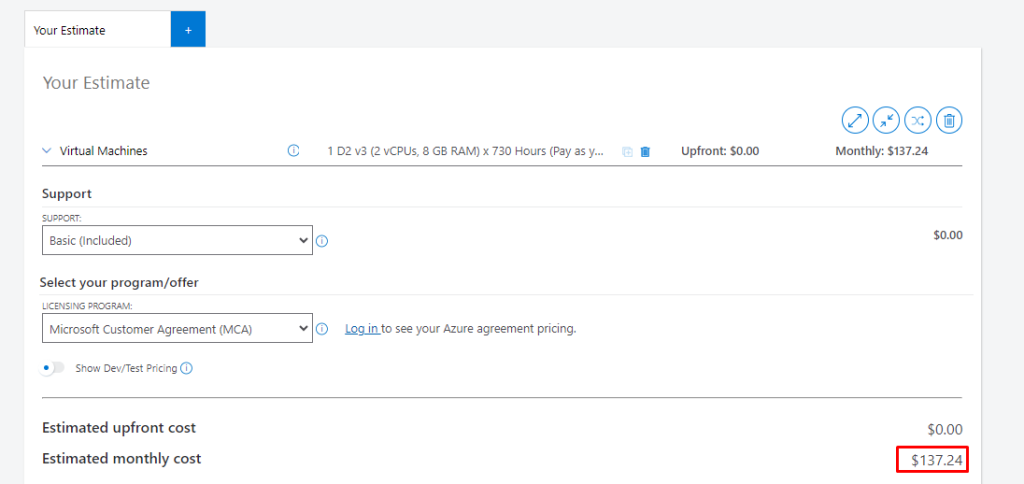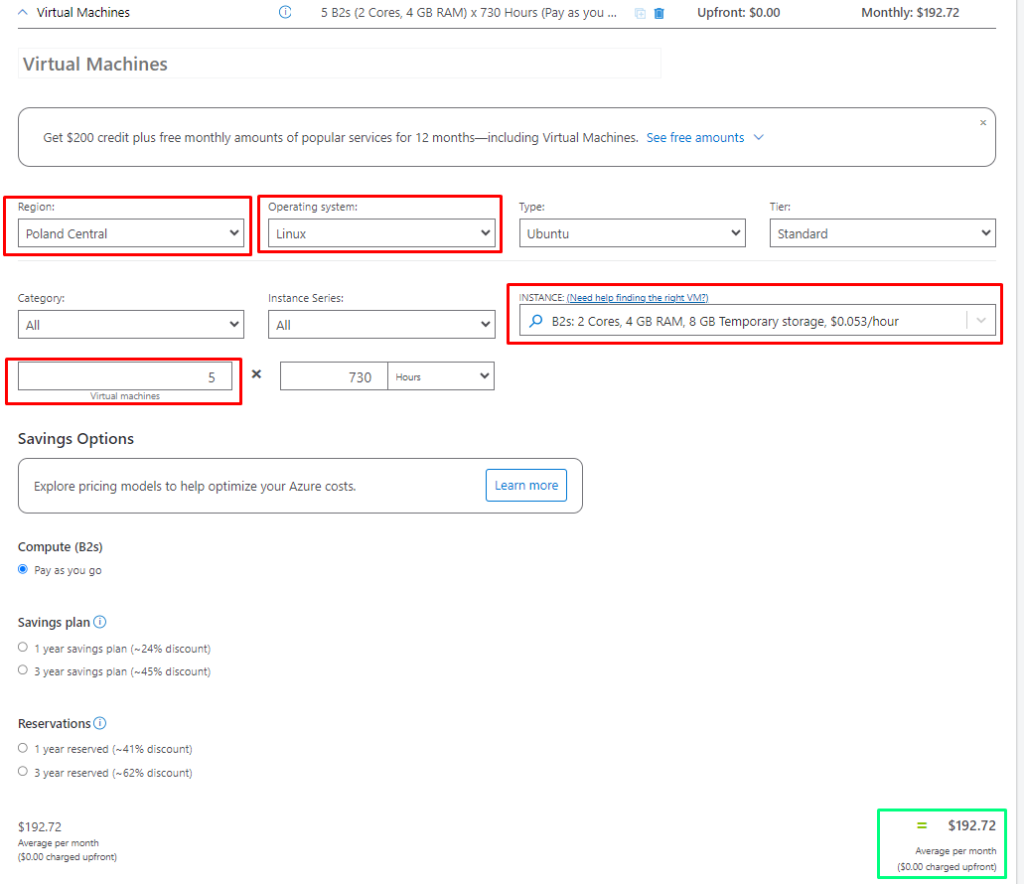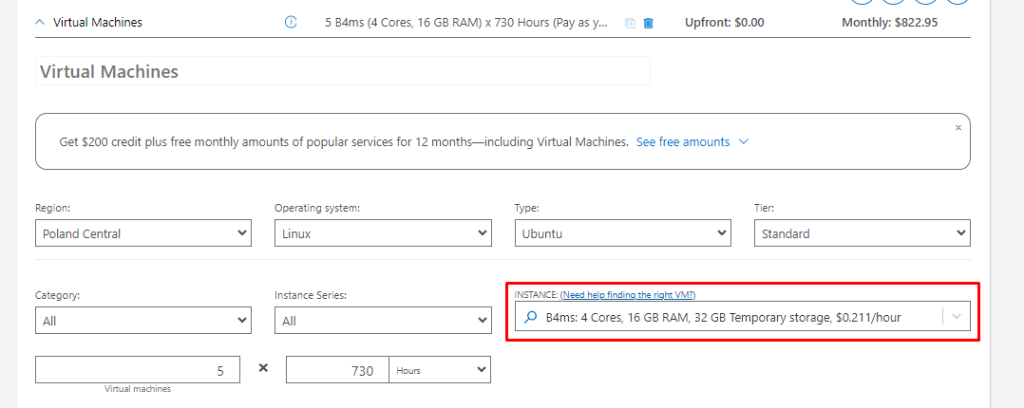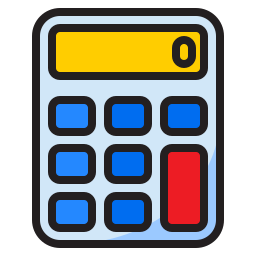Whether you are individual learning Azure or you plan to migrate your on-premise resources in there, one of the first drawbacks you will experience is pricing. Price is definitelly important factor not only when it comes to Azure, but for the cloud in general. Based on the price, you will often times wonder:
- What SKU should I use ?
- What redundancy should I choose ?
- Should I apply high availability ?
- Should I use VM with fast SSD or just basic HDD ?
- etc.
Thankfully, Azure has means to calculate cost for your resources – Azure pricing calculator. In this tutorial I will first explain how to use azure pricing calculator and then I will use simple example in which the calculator will estimate the cost of my resources.
How to use azure pricing calculator
First go to https://azure.microsoft.com/en-us/pricing/calculator/, which is actual calculator. The website consist of 3 main sections:
- Microsoft menu in the upper screen
- Resource finder in the middle
- Estimated costs at the bottom
We are only interested in resource finder and estimated costs:

Using searchbar you can find any resource in which you are interested in and add it to the calculator. I did not add any resources yet, so there are not any costs. Let’s say that I have small business which consists of 3 employees. I want to use Azure as my cloud and therefore I will add 3 VMs, 1 for each employee.
After adding it to the estimate, the price rose up as follows:

- As you can see, the price for 1 VM with default values is 137 dollars.
However this is just for one VM and with default values. Let’s say that I want different VM setup. I can click on the arrow on the left side and then I am presented with multiple configuration options. I will change the operating system to Linux. I will also change the instance from D2 v3 to B2s, because I assume that the employees will need only little computing power on their VMs. I will also increase the count to 5 and change region to Poland central:

- As you can see by editing the various settings I have managed to cut down the estimated costs from 137 dollars for one VM to 192 dollars for 5 VMs.
There are other options for VMs as well, such as Managed disks or Storage transactions, but for the simplicity I left it with default values, but feel free to explore them as well.
Example – estimating cost for various resources
Previous example was simple enough to explain how the pricing calculator works. Now I will use more advanced calculation, so that it mirrors real life scenario.
Scenario: Hypothetically, let’s say that I own travel company. More specifically IT department. Now this department is developing software which is used by other employees. For example this travel company has it’s internal web. Employees use this web in order to put users in specific flight.
So based on the requirements, we will need this resources:
- VMs for developers
- VNets in order to do networking between VMs
- VPN so that developers can securely connect to VMs
- App service which will host the internal web
- SQL database for the internal web
- Azure devops so that CI/CD can be implemented
- Azure firewall in order to protect VMs as well as internal web
As you can imagine, I could continue with resources based on my requirements. For example I might want to increase the overall security and therefore use the Microsoft Sentinel, which is SIEM system. Anyway, let’s continue with specified resources and add them to the pricing calculator, so that we can estimate the price:
Virtual machines
For VMs I chose to use B4ms instances. Developers need efficient machines. Nowadays, there is a lots of software included when it comes to developing. This software is often time very performance demanding, such as Microsoft Visual Studio, Docker, Extensions, etc. I also chose to use 128GB SSD.


- Final price for 5 VMs is 822.95 dollars.
VNETs
In order to connect our various resources by network, we need VNETs. It is pretty cheap when it comes to Azure. The only price you are paying for is peering.

- The final monthly cost is 4 dollars.
VPN
Setting up VPN gateway in Azure is for free. You are however charged for the amount of data that is passing through VPN. I chose to use 3000GB of data, leaving one developer on 600GB per month on average.

- Monthly cost for VPN is about 232 dollars.
App service
As I was mentioning before, the internal software needs to be hosted as well. Let’s assume that this software is in the form of web. For this use case I will use App Service, which is resource exactly for webs. This hypothetical company is considered to be small to medium in size, so for employees working with software I used S2 instance.

- Monthly cost for App Service is 138.70 dollars.
SQL database
The internal web needs to save it’s data somewhere. For this purpose I chose to use SQL database. I chosed 2 vCores, provisioned compute tier and standard series. Because of this requirements, the price for database is pretty high. On top of that I also chose to use Disaster Recovery with Primary or Geo replica.

- Price for the entire sql database with Disaster Recovery is 390.41 dollars.
Azure devops
Azure Devops is a must when it comes to developing in Azure. This time I was lucky enough, because Basic Plan license is free for first 5 users. The pipeline will be able to run only one parallel job at the time, but for me it is a good tradeoff considering the price.

- The montly cost for devops is 0 dollars 🙂
Azure firewall
As a last step I want to enforce the security. Firewall is first line of defense when it comes to that. Setting up the filtering, rules and alerts is a must.

- As you can see pricing for firewall is not cheap but it is definitelly worth it. The monthly cost is 912.50 dollars.
Final cost
Having everything summed up, the cost for running this company in cloud is about 2500.92 dollars which at the time of writing this article convert to 2265.13 eur. There are some places where you could save some money, but you have to consider your risks at first. For example, you can save about 900 dollars by not using Azure Firewall, but then you are lowering your security by big margin.

Conclusion
In this post, I introduced you to Azure Pricing Calculator. In first part I showed you what it is and how to use it. In second part I created hypothetical scenario in which I own the company and I want to move to the cloud. I chose to pick various resources so that you get an idea how the pricing might work for different use cases.
If you want to move to Azure or you are already moving I highly encourage you to start using calculator as soon as possible. It is good practice to calculate the cost of your resources before actually creating them. In this way, you avoid unwanted highly costs associated with resources.

